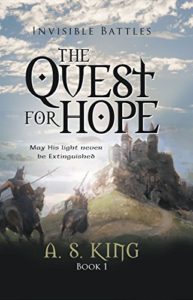My dad is half-Navajo and spent several years of his life on the Navajo reservation. Due to this heritage, I grew up hearing stories of the supernatural workings there. My favorite stories were the ones where God’s power protected His people against the curses sent against them by a medicine man.
In order to curse people, Navajo medicine men send Skinwalkers to collect a piece of DNA from the victim, such as fingernail clippings or strands of hair. Then they use what looks like a crystal ball to locate the target and send the curse. However, this doesn’t work so well with Christians. Christians are masked by a cloud in the medicine man’s ball and the curses don’t work against them. Instead, the curses bounce back on the medicine men. For this reason, medicine men either won’t curse Christians or will charge extra.
While these stories scared me with the idea of the curses and Skinwalkers, I loved the imagery of God being so close and personal in His protection. As a child, I collected angels as representations of this protection, hunted down every “angels among us” story I could find, and consumed almost any book written by Frank Peretti. The idea that there was this beautiful, shimmering being by my side looking out for me on behalf of God was immeasurably comforting.
As my knowledge of the Bible increased, I took another look at some of the angel references. Unfortunately, they didn’t fit my childhood fantasy. For one thing, they were all male. For another, it seemed like they were all big and intimidating, otherwise why would they need to tell every person they appeared to, “Do not be afraid.” Still, despite their bigger, more masculine, and warrior-like depiction, angels are shown in the Bible to be both messengers and protectors.
I took a step back and thought more about what my childhood perception meant and communicated to me. As inaccurate as the form may have been, my idealized fairy-representation of angels relayed the accurate truth that
God is always with me, that He is gentle, loving, and is there to protect me. It assured me of His presence in a way I could understand and helped me realize that He is looking out for me and is there to fight my battles.
In writing Invisible Battles: The Quest for Hope, I utilized both my past and present understanding of angels. The angelic creatures (Erela) are described as shimmering warriors who wage war against Satan (the Dark One) and his demons (Chashaks). The Erela work on behalf of the High King (God) to serve and protect the mortal creatures He created. As I crafted the supernatural scenes, I was driven by one primary goal: to encourage readers that no matter how dark and scary the evil appears, God is present. He’s stronger and greater and is fighting for them. He is always there and because He’s there, we don’t need to be afraid.
 Written by Jenny Fulton in collaboration with the vision of Eric Griffin (under the inspiration of the High King).
Written by Jenny Fulton in collaboration with the vision of Eric Griffin (under the inspiration of the High King).
In the newly created land of Novus, a powerful and immortal being known as the Dark One has all but succeeded in erasing the name of the High King from the hearts and minds of the people. The battle, however, is far from over. Unbeknownst to the Dark One and his minions of Chashaks, the High King has been at work among a loyal group of followers. Now he is ready to make his move.
Invisible crystalline beings known as Erela are being sent out across the land to seek out those who are willing to play a part in this unfolding story. Among them is a young apprentice named Levi. Having never traveled beyond the borders of his own home, Levi is sent forth on an important and dangerous mission. In another part of the kingdom, Aliatta, a proud young royal, is about to have her safe and comfortable world turned upside down. Seemingly opposite in almost every regard, these two young people soon find their lives intertwined in a cosmic quest for hope and truth.

Jenny Fulton is a published YA fantasy author and freelance writer with a B.S. in elementary education, an endorsement in K-12 ESL, and over ten years of experience teaching in a variety of cultural and educational settings, both abroad and in the United States. Her days are now spent raising three young daughters and writing as much as time and opportunity allows.
Connect with Jenny:
